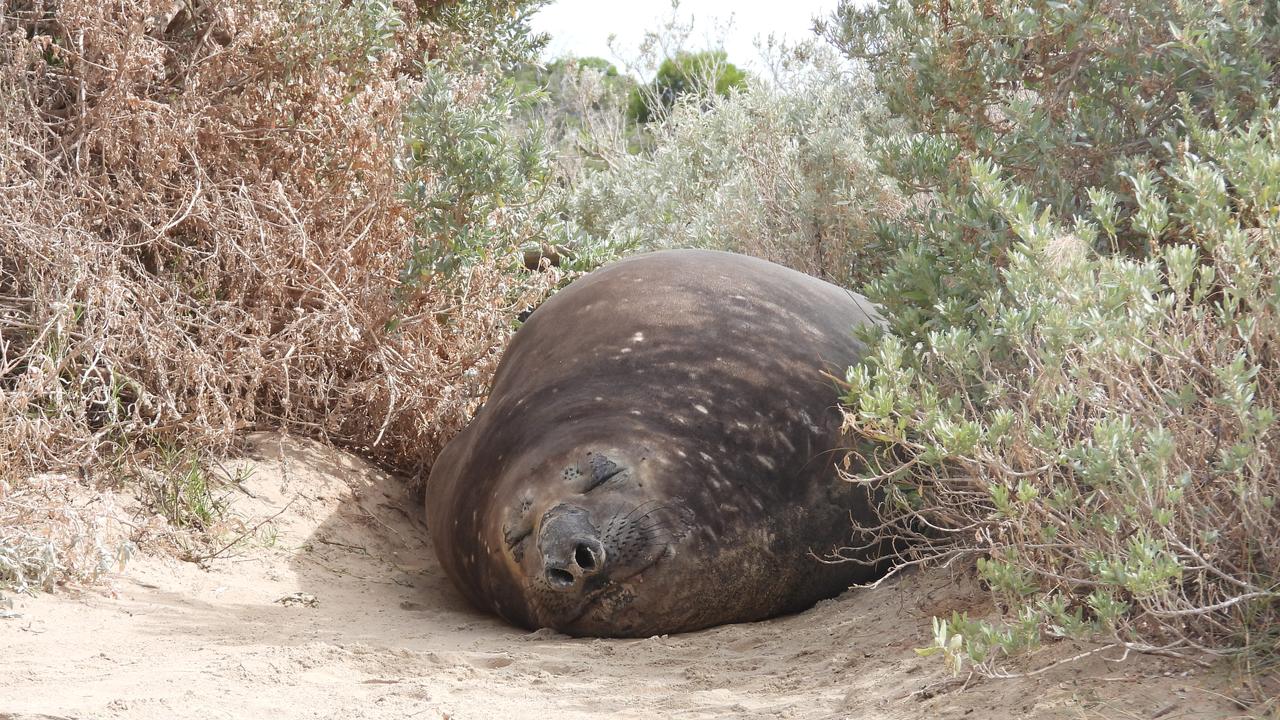Henry the southern elephant seal visits Victorian seaside towns
A southern elephant seal nicknamed Henry caused quite a commotion over the summer holidays, dropping in on two busy Victorian seaside towns

READING LEVEL: GREEN
An adventurous seal caused quite a commotion* over the summer holidays when he popped up on a Victorian beach a couple of days after causing havoc* in the streets of another seaside town.
Henry the southern elephant seal flip-flopped down a busy street in Point Lonsdale, 103km southwest of Melbourne, on January 20.
He emerged from Port Philip Bay and sauntered* his way to the carpark before trying to get inside a corner petrol station.

The super-sized seal drew a large crowd of onlookers, while police and wildlife officers cleared the area and his path back to the water.
But three days later Henry reappeared, this time on the other side of Port Philip Bay at Blairgowrie, 87km southeast of Melbourne.
Again Henry became a bit of a celebrity with people in the area, prompting authorities to close the beach and issue a warning to stay away.
“We know it’s exciting to see such large and unique animals on our beaches, but a photo or video opportunity is not worth risking your or a seal’s safety,” said chief conservation regulator Kate Gavens.
Ms Gavens said wildlife authorities were disappointed to see onlookers get dangerously close to the animal in Point Lonsdale and did not want a repeat of the behaviour at Blairgowrie’s Camerons Bight Beach.

Seals are known to visit and rest on Victorian beaches and can become defensive if approached by humans or other animals, so it is important for people to keep at least 30m away or 50m away if with a dog.
Seals and other wildlife are protected under Victorian law. People who intentionally injure, disturb, chase, herd or feed seals face a fine of up to $3698.
Henry is thought to be aged about five and weigh 500kg, which means he is still growing.

ELEPHANT SEAL FACTS
- Southern elephant seals are named after the large nose of the adult males, which is used to make loud roaring sounds, especially during mating season.
- Male seals are known as bulls and females are called cows.
- Southern elephant seals are the largest seal species. Adult males weigh up to 3000kg, adult females weigh 300kg-900kg and pups weigh about 40kg at birth.
- They are big and cumbersome* on land, but superb swimmers and divers. Biologists have recorded them diving up to 2km deep and holding their breath under water for up to two hours.
- They spend about two minutes on the surface of the water between dives, with most dives lasting 30 minutes and to a depth of 300m to 800m.
- Their torpedo shape helps them dive.
- They have also adapted to have an enormous volume of blood that stores oxygen, which they use very efficiently*. They even have extra spaces called sinuses in their abdomens to store extra blood. Their muscles are also used to store oxygen. This means they can make the oxygen in their body last a long time between breaths.
- Southern elephant seals have a thick layer of blubber that sustains them during the breeding season (September to November) as they do not feed during this time.
- They moult* their hair and skin from January to April.
- Southern elephant seals migrate* south to Antarctica to feed on squid and fish at the edge of the sea-ice after breeding or moulting.
* Source: Australian Antarctic Program, Department of Climate Change, Energy, the Environment and Water
GLOSSARY
- commotion: a lot of noise, confusion and excitement
- havoc: mayhem, damage
- sauntered: walked in a slow and relaxed way
- cumbersome: large and heavy and therefore difficult to move
- efficiently: in a way that provides maximum benefit with minimum effort
- moult: shed, lose covering of hair/feathers/skin to make way for a fresh one
- migrate: move from one area to another, usually when the season changes
EXTRA READING
Seals in hi-tech helmets help Antarctic study
Fur seal is 25 and still going strong
Why do grey seals clap like humans?
QUICK QUIZ
- Which two Victorian seaside towns did Henry come ashore at?
- What did authorities do when he came ashore at the second town?
- How far away must people stay from seals?
- How old is Henry thought to be?
- How long can seals hold their breath under water?
LISTEN TO THIS STORY
CLASSROOM ACTIVITIES
1. Descriptive words
Come up with at least 10 adjectives (describing words) to describe Henry the seal as he moved along the beach and main streets.
Draw a picture of Henry and place your adjectives around the picture.
What questions do you have about Henry? Discuss with a partner.
Time: allow 25 minutes to complete this activity
Curriculum Links: English, Visual Arts, Personal and social, Critical and creative thinking
2. Extension
Design a sign to put around the beaches to warn people to leave seals alone and to keep at least 30m away from them, or 50m if walking a dog on a lead. State the consequences of what happens if people disobey these rules.
Time: allow 20 minutes to complete this activity
Curriculum Links: English, Visual Arts
VCOP ACTIVITY
A Surprise visit
Henry has been a wonderful surprise visit to beachgoers. Have you ever had a surprise visit from a person or animal that you weren’t expecting. Was it a good surprise or not?
Share with us a time when your visitor surprised you.
Don’t forget to use your VCOP skills to engage and connect with the audience.
Re-read your work to ensure it is clear and makes sense.

